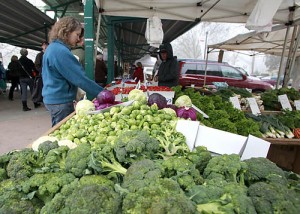 Nitrogen, an essential plant nutrient for food crops, is a hot topic right now in California agriculture. Next week, a team of university researchers is scheduled to release a report on nitrate in groundwater in the Tulare Basin and Salinas areas. So I thought this was a perfect time to take the issue before the California State Board of Food and Agriculture. Our meeting earlier this week focused on the complexity of nitrogen in the environment and the opportunities for farmers to improve management of it in the future.
Nitrogen, an essential plant nutrient for food crops, is a hot topic right now in California agriculture. Next week, a team of university researchers is scheduled to release a report on nitrate in groundwater in the Tulare Basin and Salinas areas. So I thought this was a perfect time to take the issue before the California State Board of Food and Agriculture. Our meeting earlier this week focused on the complexity of nitrogen in the environment and the opportunities for farmers to improve management of it in the future.
The presenters included Dr. Tom Tomich of the Agricultural Sustainability Institute at UC Davis, who shared a number of important points and preliminary data with us from his ongoing California Nitrogen Assessment (Link to power point). Dr. Tomich reminded us that this is a global issue; that nitrogen is everywhere in the environment – air, water and soil; and, perhaps most significantly, that any large-scale efforts to mitigate nitrogen movement to groundwater should be a dynamic process that fosters innovation and should not include a one-size-fits-all approach.
Agriculture has long recognized the need to manage the journey of nitrogen after it does its job as a plant food. For farmers, this presents challenges, sure, but also opportunities. Scientific data over the last two decades show that growers are using the same rate of nitrogen fertilizer and crop acreage to produce more food. This clearly demonstrates that growers have become more efficient with nitrogen fertilizer use. Dairy farmers have demonstrated their environmental commitment for many years through the California Dairy Quality Assurance Program, which includes important third-party evaluations before certification. Dairies are also adhering to a waste discharge regulation that, since it went into effect in 2007, has provided more direction for environmental stewardship.
Looking ahead, there are some important questions to address. Can nitrates be captured so they are effectively used and stay in a food crop production “box,” which would limit their movement elsewhere in the environment? Can vegetation be managed to trap nitrates better? Are there devices available that actually filter nitrate out before it can move into the state’s waterways? We know the answers to each of these will require scientific research and resources. I am confident that farmers and the scientific community will continue to work together to lead us into a future with better management of nitrogen in our state’s highly diverse agricultural systems.


